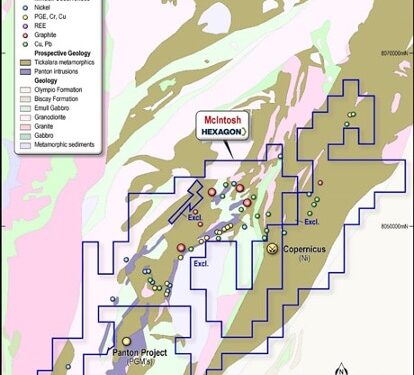Hexagon Energy Materials Ltd (ASX: HXG) is preparing for an important upcoming mineral exploration at its McIntosh Ni-Cu-PGE Project in the East Kimberley Region of northern Western Australia.
The current drill programme has been delayed from the proposed September commencement date due to a protracted process in securing final heritage approvals.
The Priority 1 drill targets which include IP Anomaly A and B, which were discovered by Hexagon in an IP survey over the Greater Mellon Patch area conducted in 2021, along with Anomaly 22 and Anomaly 9 which were highlighted in a geophysical review over the project. The identified drill targets are prospective for metallic disseminated to massive sulphide Ni-Cu-Co-PGE mineralisation.
“We are excited to finally be on the cusp of this much anticipated drill programme,” Chairman Charles Whitfield said.
“The administrative delays have been frustrating but the company has made the most of the additional time to drilling by conducting additional ground work that should hopefully enhance the efficiency of our targeting. We look forward to being able to inform the market as to progress during the course of the programme.”
Drill Programme
The current drill programme will be testing the following high priority geophysical anomalies:
• Two untested airborne electromagnetic (AEM) anomalies Anomaly 22 and Anomaly 9, and
• Two untested ground Induced Polarisation (IP) anomalies A and B.
Hexagon personnel and drilling contractor are currently mobilising to site with drill pad preparation
being undertaken over the weekend, with drilling due to commence early next week.
IP Anomalies
The Melon Patch intrusion was identified as a priority Ni-Cu-PGE target by Hexagon in 2021. A Reconnaissance dipole-dipole IP/resistivity surveying of the northern margin of the Melon Patch mafic-ultramafic intrusive complex was completed in 2021). The survey was designed to cover an area of strong Ni- Cu anomalism in soil geochemical sampling and to extend into the country rocks a sufficient distance to cover potential feeder dykes, structurally remobilised mineralization, etc.
A chargeability anomaly (A) was defined, close to a Ni-Cu stream sediment geochemical anomaly (anomaly A), with a second anomaly (B) thought likely to be associated with graphite, owing to its high conductivity.
Two in-fill survey lines of dipole-dipole IP/resistivity IP were read to the north of the existing line in August 2022. This follow-up was intended to provide a more accurate definition of the 3D geometry of the chargeable sources and their size than that provided by the reconnaissance lines.
The results of the infill IP survey now indicated that two previously separate IP Anomalies (A and B) may be part of the same geological body, with the conductivity varying across the body, which will be tested in the current drill programme.
During the historical geophysical survey data review, two previously discounted AEM anomalies were identified which Hexagon will now test in the current programme.
Helicopter EM Anomaly 22
AEM anomaly 22, lies within the Melon Patch North prospect, the geological mapping undertaken by Hexagon now has this anomaly situated within a remnant of the potential Panton Sill type intrusive, bound to the north by Tickalara Metamorphics and to the east by the Sally Down Suite.
Two previously reported rock chip samples MCI089 & MCI090, collected during historic geological mapping programmes, returned anomalous Cu value with chalcopyrite and very fine-grained disseminated sulphides were observed in MCI090.
Historically, this anomaly had been dismissed as it had been thought to be graphite related. Modelling undertaken by Hexagon geophysical consultants on Anomaly 22 VTEM response indicates a complex, possibly folded, structure formed by moderately conductive bodies more consistent with matrix or net-texture rather than massive sulphide. Two plate conductors were modelled, and a single hole designed to test both model conductors within this current programme.
Hexagon successfully applied for and secured funding through the Western Australian Government’s Exploration Incentive Scheme to co-fund drilling. A total of $30,000 has been secured, with this funding used to cover part of the cost of drill testing Anomaly 22.
For further information please visit: https://hxgenergymaterials.com.au/












